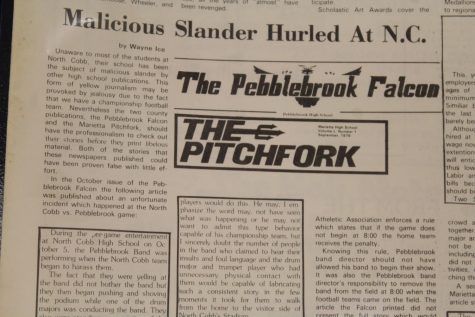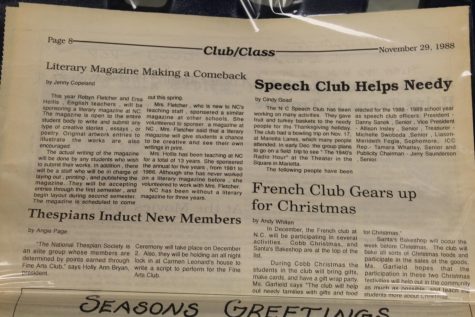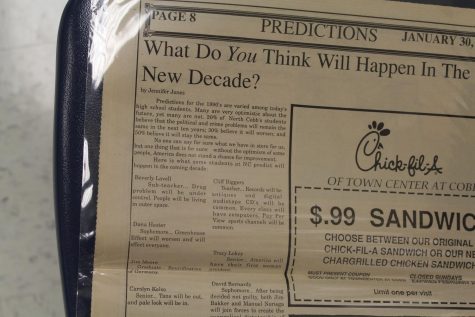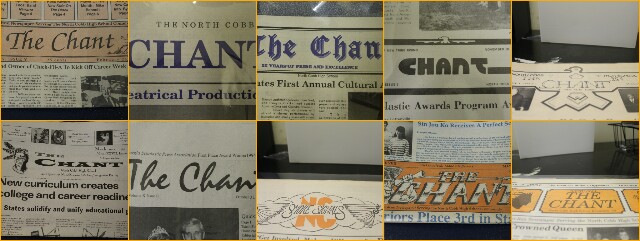Evolution of The Chant
The photograph features various logos for The Chant used throughout the years. The years from left to right, include 1979, 1982, 1983, 1992, 1993, 1995, 1997, 2012, 1994, and 1984.
September 10, 2018
Throughout the 60 years of NC history, features and additions submitted themselves to modification to fit with the times, to varying levels of success; not all of said features survived the process, but The Chant certainly managed to ride it out. First founded in 1974 as a for sale paper magazine, NC’s school newspaper remains a mainstay, and its digital integration in 2013 allowed for further ease of access. While The Chant underwent a wide array of revamps, redesigns, and overall structure changes leading it into its current form.
The Chant, like all other journalistic publications, prefers to keep news stories as just that, out-and-out news, without bias; this did not always happen, however. As seen in the physical newspaper published November 30, 1979, an article calling out “malicious slander” and “yellow journalism” (substituting direct facts for provocative headlines) directed toward NC by Marietta High School’s publication Pitchfork and Pebblebrook’s Falcon got to the public; that headline and its accompanying story marks, to date, the only time The Chant ever publicly and actively engaged in any form of altercation with the periodical of another school.

A 1979 issue of The Chant lambasts Marietta High and Pebblebrook for yellow journalism against the paper. No response from either two schools seems present in the issue.
In addition to publishing stories with more hostile undertones, more controversial topics received coverage, as seen with a January 1980 paper covering the question of creation vs. evolution, a topic The Chant now cannot cover without permission from the school administration. Finally, as opposed to the current preference of local news coverage above all else, The Chant of yesteryear covered a fair share of both national and global news, seen in the coverage of the Youth Opportunity Wage Act and the PLO-Bandak conference in August and November issues respectively from 1979.
Not dissimilar to publication rate and story length, the style of writing tends to vary between publications, mostly in regard to the formatting of and words used in stories. The contemporary Chant follows The Associated Press Stylebook (AP) for writing, and all the rules it entails, like avoidance of words such as “is,” “things,” and variations of “be” and “have,” and while eagle-eyed readers may notice this trend, the rule did not always exist, as physical issues running as late as the early 90s contained these words, like an August ‘79 issue, containing usage of “is,” ‘begun,” and contractions, words commonly frowned upon in the handbook. Bucking future trends applied to more than just writing, though: even the photos broke modern guidelines. As a rule of thumb, candid, “in the moment” photos always introduce articles, with no exceptions. On the other hand, the proto days of The Chant and its stories seemed almost exclusively adorned with staged photos, a trend seemingly only contested for sports stories. Even headlines for stories seemed vaguely repetitive, with the phrase “does well” popping up throughout the print issues.

An example of the heavy emphasis placed on club activity in The Chant issues of yesteryear. The French, Speech and Debate, National Thespian Society, and Literary Magazine clubs (the latter two of which are disbanded) as well as their achievements, lay immortalized for viewers to behold.
Considering all the clubs and teams present at NC, as well as all that they do, it stands that they would receive a fair share of attention, and they do: one-fifth of the main pages (sports) exclusively covers teams, and a generous chunk of news and features cover clubs, teams, or specific people involved therein. This sentiment definitely applies to the early days of The Chant, where the proceedings of the school groups received heavy documentation; a November 1988 issue contained four entire sections dedicated to the Model United Nations, French, Speech, and Thespian clubs. In fact, upon re-reading older articles, it seems the prior staff seemed concerned with NC happenings above all else. The presence of club shorts (bulletin board-esque sections for clubs), student achievement portions, monthly highlights, and a news brief section all back up this sentiment.
Unlike their more traditional, printed counterparts, online newspapers tend not to offer reader interactions, with the reasons for such varying from a desire to come off as professional, to software limits within the site itself, or a simple inability to consistently create daily forms of reader interaction. Among these forms included a small, fun-and-games portion, which provided daily horoscopes alongside games like sudoku and crosswords; this portion highlights the more passive forms of student interaction with the paper in years past.
But ways in which students could engage with the newspaper did exist, like “Letters to/from,” a “Dear Santa” section for the holiday season, and a yearly predictions section in January issues. While all this seems a fun set of additions, one cannot help but wonder how all this could properly find its way into each and every issue; an interesting question, one perhaps explained by the fact that at times, issues would see release only once a month.

The final physical copy of The Chant was published in 2013, and since then, the publication transitioned to an online format, the one currently used today, and while the new format does bring with it its fair share of benefits, namely not coming behind a paywall, staff members for The Chant still would like to remember the days that lead to the newspaper becoming the award-winning one that now exists as; to do so, The Chant started its own archive section, containing physical copies of old Chant newspapers and the content within, preserving the past for future generations.








Turner Markwalter • Sep 10, 2018 at 12:47 PM
Ashu, you always manage to make my day whenever I see you post an article. Keep up the amazing work, brother.